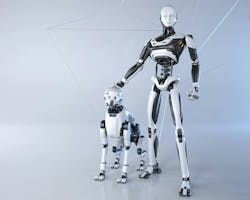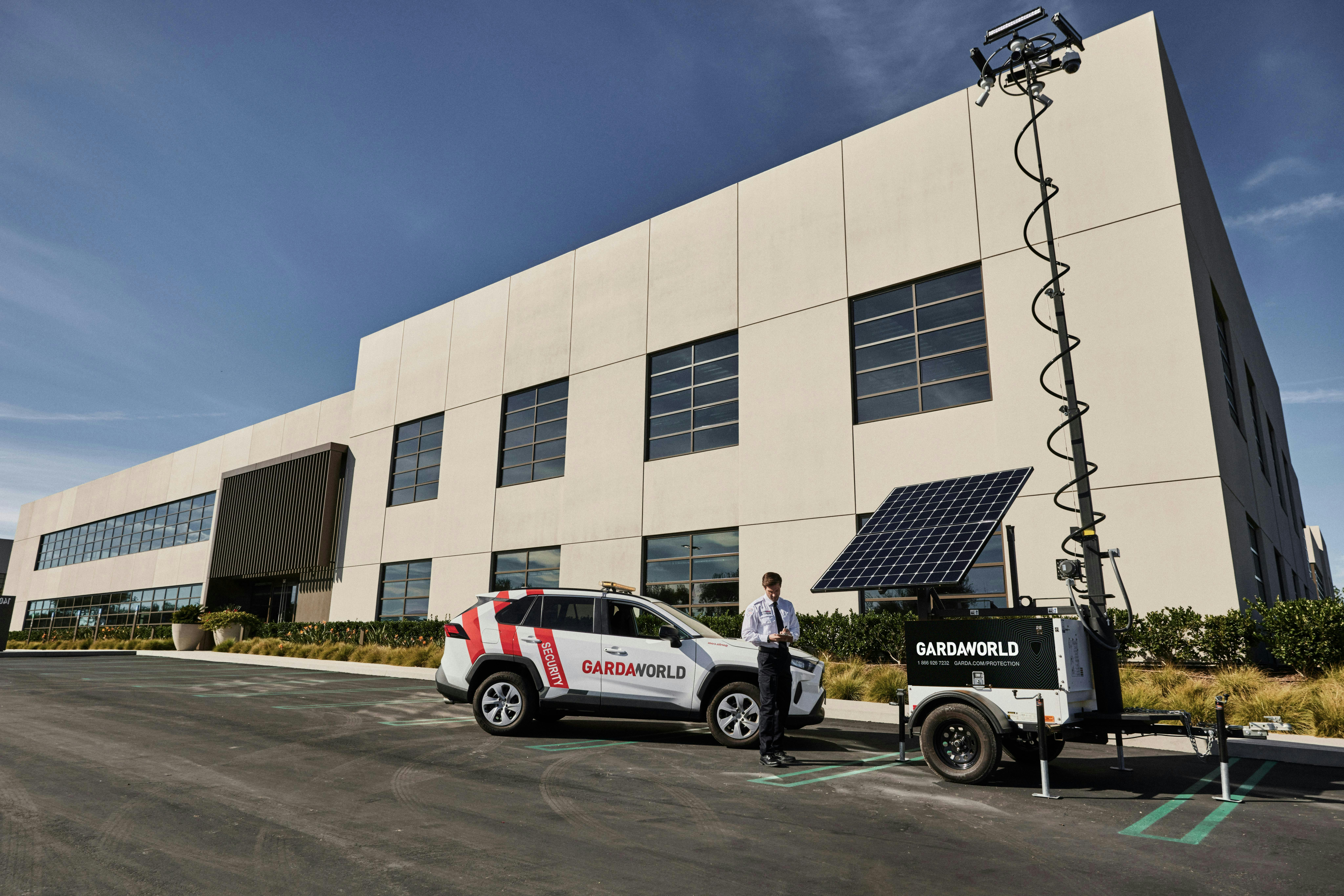How to Navigate the Future Using Hybrid Robot Guard Forces
Security measures are changing to better protect against evolving threats. Hybrid security solutions, a combination of traditional security and advanced technology, are the next line of defense against a widening variety of threats and risks. Hybrid solutions improve efficiencies and allow the human guards to focus on more complex, higher-value security and safety tasks.
Contemporary threats have grown more sophisticated and adaptive in tandem with technological and business advancements. Given that new risks are more challenging to anticipate, unwavering vigilance and expertise are imperative. Utilizing security technology, along with traditional guarding, is now important for organizations to be able to safeguard their critical assets in ever-changing environments.
The landscape of security protocols has also undergone a transformative evolution with the remarkable advancements in Robot Guard Technology (RGT). First, RGT has revolutionized surveillance capabilities by outfitting robots with advanced cameras, sensors, and AI algorithms. This integration has elevated vigilance levels, enabling real-time monitoring and precise threat detection.
Second, the deployment of autonomous patrol robots has become a cornerstone of many security strategies. These robots autonomously navigate predefined routes, ensuring continuous monitoring and swift responses to potential threats, thereby enhancing overall security measures.
Third, the integration of artificial intelligence into RGT has significantly boosted the adaptability of robots to dynamic environments. Machine learning algorithms empower these robots to recognize patterns and make informed decisions, substantially improving their threat identification capabilities.
Finally, RGT has seen communication enhancements with the incorporation of sophisticated tools, facilitating seamless interaction with manned guard forces. This ensures coordinated responses to security incidents in a collaborative security environment, underscoring the comprehensive and cutting-edge nature of contemporary robot guard technology.
Robot Patrol Units
While portable security systems are not new, mobile surveillance units, like those offered by ECAMSECURE, typically operate independently of an organization’s IT network and are often complemented by command centers that allow for effortless addition, replacement, and relocation of surveillance units across diverse environments. The next frontier in mobile surveillance is the “robot watchdog” or robot patrol units. These automated systems use artificial intelligence and machine learning to improve monitoring.
The landscape of security protocols has also undergone a transformative evolution with the remarkable advancements in Robot Guard Technology (RGT).
Trends are moving towards more independent and intelligent units that can efficiently patrol and secure different areas. Robot patrol units, inspired by their canine counterparts, navigate diverse terrains with ease, serving as visible deterrents equipped with sensors to detect intruders or potential threats. These additions enhance situational awareness, contributing to overall security posture, particularly in outdoor environments. With features like facial recognition and real-time data analysis, this tech enhances security but also makes operations smoother with abilities to communicate with stationary surveillance units or command centers. As businesses prioritize automation, the use of these robotic guardians is likely to increase, changing how surveillance and security are handled.
Law enforcement is also relying more on robot patrol units as a crucial first line of defense in hazardous and potentially dangerous situations. These robots are deployed in advance to thoroughly survey the situation and surrounding areas. This proactive approach provides law enforcement with valuable insights, helping them assess risks and make informed decisions. It not only improves overall safety but also ensures officers have crucial information before arriving at the scene. By using these robotic technologies, law enforcement aims to minimize risks and dangers faced by officers, making it a strategic and effective use of advanced tools in the field.
Smart ID Authentication
The smart combination of Smart ID authentication, AI-powered cameras, and speakers change how visitors experience security. Using Smart-ID authentication in the security setup is a modern approach, demonstrating the inclusion of artificial intelligence in access control. AI-powered cameras are crucial in handling visual data, supporting the growing trend of improved surveillance capabilities. By using these technologies, the system not only provides a personalized and secure entry process but also contributes to the overall trend of using advanced robotic solutions for comprehensive security. This forward-thinking integration showcases how AI and smart ID authentication systems come together to create more efficient and secure environments.
Virtual Guarding
Virtual guards are also among the current trends of robot guard technology, using advanced technologies like artificial intelligence and machine learning to monitor and protect spaces from a distance. These digital sentinels have real-time surveillance abilities, efficiently examining large amounts of data to identify potential threats. This fits into the broader shift towards automation in security, offering a cost-effective and scalable solution. Virtual guards improve overall security measures, displaying the integration of intelligent systems in the changing world of RGT.
In line with this trend, virtual guards work together with Mobile Security Units (MSUs) to create a dynamic security system. MSUs are designed for quick deployment and mobility, strategically placing themselves to support virtual guards and ensure a coordinated and responsive security network. This teamwork optimizes security operations in large or dynamic environments, using artificial intelligence and real-time data analysis. The collaboration between virtual guards and MSUs demonstrates the adaptability of robot guard technology, ensuring a comprehensive and proactive response to changing security challenges.
Interoperability
Interoperability with human guard forces is crucial for the successful integration of RGT components. This requires the establishment of standardized communication protocols for real-time information exchange, ensuring a cohesive response to security incidents. Making sure that all components have a defined role within a security operations program and complement each other and creating the right redundancies will lead to success.
Comprehensive training programs are important to help familiarize human guard forces with the capabilities of MSUs and robot watchdogs, building trust through collaborative exercises and simulations. The integration of smart ID authentication and virtual guards into security operations ensures a secure and efficient access control system and complementary surveillance capabilities, creating a comprehensive and technologically advanced security ecosystem. Centralized command centers equipped to monitor and control RGT enable swift decision-making and coordination in response to security incidents. This type of holistic approach exemplifies the evolving landscape of security protocols, integrating advanced technologies to create a more resilient and responsive security infrastructure.
Future of Robot Guard Technology
RGT is gearing up for wider use across different sectors, marking a significant shift in modern security practices. It's expected to play a vital role in securing crucial infrastructure like power plants, transportation hubs, and data centers. The constant vigilance and quick response abilities of robots boost the resilience of these important facilities.
Additionally, deploying RGT at large-scale events or crowded public spaces like malls or airports is becoming more common. In these settings, robots can navigate through crowds, identify potential security risks and work alongside human security personnel to ensure the safety of attendees. In remote or hazardous environments, RGT offers an effective security solution, reducing human exposure and lowering risks.
Healthcare facilities can also benefit from the deployment of robot guards, ensuring the safety of patients, staff, and sensitive medical equipment. These robots might also play a role in monitoring compliance with health protocols. Moreover, autonomous security robots could patrol large areas such as parking lots or outdoor spaces, preventing unauthorized access and enhancing overall safety.
In industrial settings, robot guards can monitor equipment, detect anomalies, and ensure compliance with safety protocols, contributing to safer working conditions. Autonomous robots with surveillance capabilities may also find use in customs and border control settings, enhancing monitoring and detection of illegal activities.
The versatility of robot guards is evident in retail stores and hospitality settings, where they can be used for tasks like monitoring inventory, detecting shoplifting, and ensuring the safety of customers and employees.
In conclusion, the ongoing trends in AI and machine learning are reshaping security practices, pushing robot guards towards greater intelligence and adaptability in response to evolving security scenarios. The collaboration between robot guards and human security personnel is a forward-looking approach, leveraging the strengths of both to enhance overall security effectiveness. Additionally, the capability for remote monitoring and control opens new dimensions in security operations, allowing for timely interventions and guidance. The synergy between human intuition and robotic precision, exemplified by mobile surveillance units and robot patrol units, demonstrates the potential of technology to create a safer and more resilient world. As we navigate this dynamic evolution, the integration of advanced technologies like RGT is set to redefine the future of security, ushering in an era of enhanced collaboration and adaptability in safeguarding our environments.
About the Author

Jordan Lippel, CPP
Vice-President of Sales for ECAMSECURE, a GardaWorld company
Jordan Lippel is a Certified Protection Professional with over 25 years of experience in crime prevention security technology. He has acquired security expertise in artificial intelligence, risk assessments, and behavioral intelligence. As Vice-President of Sales for ECAMSECURE, a GardaWorld company and leader in innovative, adaptable access and surveillance security solutions, Lippel is responsible for business development across North America, focusing on integrated security solutions. Lippel is also a member of the Board of Directors of ASIS International’s Crime Prevention Council, Los Angeles Crime Stoppers, the Ventura County Sheriff Foundation, and LEAPS (CAL-ORCA).


